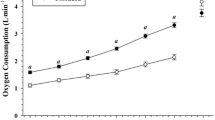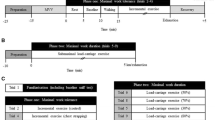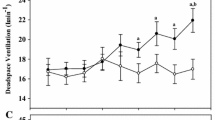Summary
The present study was undertaken to examine the energy cost of prolonged walking while carrying a backpack load. Six trained subjects were tested while walking for 120 min on a treadmill at a speed of 1.25 m · s−1 and 5% elevation with a well fitted backpack load of 25 and 40 kg alternately. Carrying 40 kg elicited a significantly higher (p<0.01) enery cost than 25 kg. Furthermore, whereas carrying 25 kg resulted in a constant energy cost, 40 kg yielded a highly significant (p<0.05) increase in energy cost over time. The study implies that increase in load causes physical fatigue, once work intensity is higher than 50% maximal work capacity. This is probably due to altered locomotion biomechanics which in turn lead to the increase in energy cost. Finally, the prediction model which estimates energy cost while carrying loads should be used with some caution when applied to heavy loads and long duration of exercise, since it might underestimate the acutal enery cost.
Similar content being viewed by others
References
Astrand I (1960) Aerobic work capacity in men and women. Acta Physiol Scand [Suppl] 49:69
Astrand P-O, Rodhal K (1977) Textbook of work physiology. McGraw Hill, New York
Cathcart EP, Richardson DT, Campbell W (1923) On the maximum load to be carried by the soldier. J Roy Army Med Corps 40:435–443; 41:12–24, 87–89, 161–178
Cobb LA, Johnson WP (1963) Hemodynamic relationship of anaerobic metabolism and plasma free fatty acids during prolonged, strenous exercise in trained and untrained subjects. J Clin Invest 42:800–810
Consolazio CF, Johnson RE, Pecora LJ (1963) Metabolic statistics. In: Physiological measurements of metabolic functions in man. McGraw Hill, New York, pp 437–452
Costill DL, Sparks K, Gregor R, Turner C (1971) Muscle glycogen utilization during exhaustive running. J Appl Physiol 31:353–356
Daniels FJ Jr, Vanderbic JH, Bommarito CL (1952) Energy cost of load carrying on a treadmill. Fed Proc 11:30
Ekelund LG (1966) Circulatory and respiratory adaptation during prolonged exercise in the supine position. Acta Physiol Scand 68:382–396
Ekelund LG (1967) Circulatory and respiratory adaptation during prolonged exercise of moderate intensity in the sitting position. Acta Physiol Scand 69:327–340
Givoni B, Goldman RF (1971) Predicting metabolic energy cost. J Appl Physiol 30:429–433
Goldman RF (1965) Energy expenditure of soldiers performing combat type activities. Ergonomics 8:321–327
Gollnick PD, Armstrong RB, Sanbert IV CW, Sembrowich WL, Shepherd RE, Saltin B (1973) Glycogen depletion patterns in human skeletal muscle fibers during prolonged work. Pflügers Arch 344:1–12
Grimby G, Nilsson NJ, Sanne H (1966) Repeated serial determination of cardiac output during 30 min exercise. J Appl Physiol 21:1750–1756
Hughes AL, Goldman RF (1970) Energy cost of “hard work”. J Appl Physiol 20:570–572
Karlsson J, Nordesjo L-O, Saltin B (1974) Muscle glycogen utilization during exercise after physical training. Acta Physiol Scand 90:210–217
Keren G, Epstein Y, Magazanik A, Sohar E (1981) The energy cost of walking and running with and without a backpack load. Eur J Appl Physiol 46:317–324
Martin PE, Nelson RC (1986) The effect of carried loads on the walking pattern of man and woman. Ergonomics 29:1191–1202
Michael ED, Hutton KE, Horvath SM (1961) Cardiorespiratory responses during prolonged exercise. J Appl Physiol 16:997–1000
Pandolf KB, Givoni B, Goldman RF (1977) Predicting energy expenditure with loads while standing or walking very slowly. J Appl Physiol 43:577–581
Rowell LB (1971) Cardiovascular limitations to work capacity. In: Simonson E (ed) Physiology of work capacity and fatigue, Charles C. Thomas Publ, Springfield Ill, pp 132
Rowell LB, Kraning KK, Evans TO, Kennedy JW, Blackman JR, Kusumi F (1966) Splanchnic removal of lactate and pyrovate during prolonged exercise in man. J Appl Physiol 21:1773–1783
Saltin B, Stenberg J (1964) Circulatory response to prolonged severe exercise. J Appl Physiol 19:833–838
Sawka MN, Knowlton RG, Critz JB (1979) Thermal and circulatory responses to repeated bouts of prolonged running. Med Sci Sport 11:177–180
Soule RG, Pandolf KB, Goldman RF (1978) Energy expenditure of heavy load carriage. Ergonomics 21:373–381
Taylor HL, Buskirk ER, Henschel A (1955) Maximal oxygen intake as an objective measure of cardio-respiratory performance. J Appl Physiol 8:73–80
Author information
Authors and Affiliations
Rights and permissions
About this article
Cite this article
Epstein, Y., Rosenblum, J., Burstein, R. et al. External load can alter the energy cost of prolonged exercise. Europ. J. Appl. Physiol. 57, 243–247 (1988). https://doi.org/10.1007/BF00640670
Accepted:
Issue Date:
DOI: https://doi.org/10.1007/BF00640670




